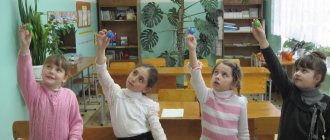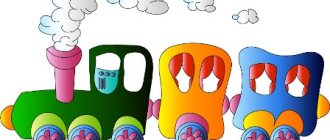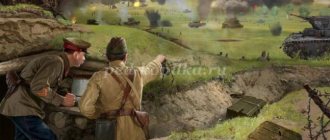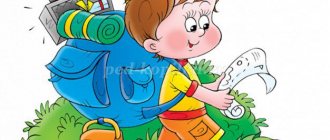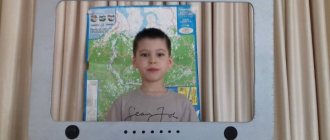Summary of the travel game in the middle group of kindergarten
Summary of the game in the middle group on the topic: “An exciting journey by sea.”
Author: Olga Aleksandrovna Frantsuzova, teacher at MBDOU kindergarten No. 2 in the village. Novozavidovsky, Konakovsky district, Tver region. Purpose: this summary is intended for teachers, educators and creative people working with children. Goal: creating an emotionally positive mood in the group. Objectives: to consolidate children’s knowledge about the underwater world and its inhabitants; Expand words knowledge; develop imagination, expressiveness of movements, facial expressions; develop the ability to listen to the sounds of nature; to form a desire to communicate in the game with peers and adults. Preliminary work: learning poetry, looking at illustrations of animals and plants, living in bodies of water, playing together. Methodical techniques: game situation, conversation-dialogue
Progress of the lesson.
Educator. Come on, let's go on an exciting journey by sea. Children. Let's. Educator . We will need to go through an interesting but difficult path with adventures and obstacles. Therefore, at each stage of our journey you will perform different tasks and exercises. And now I want to ask, who knows and can tell poems about the river, sea or aquatic inhabitants? Children recite poems. Educator. Children, do you want to go to the sea?
Children. Yes. Educator. Then you need to carefully jump on large and small pebbles. You are ready? Children. Yes. Educator. So we got to the water. Now let's lie down on the sand. Let's lie down and listen to the sound of the sea, and maybe the birds singing. We will lie down and gain magical strength to continue our journey. (Music accompaniment is turned on - the sound of the sea, birdsong). Children, having taken a comfortable position, lie with their eyes closed. The teacher gives instructions for calm and relaxation, calm breathing: “you see the wonderful sea, hear the sound of the waves, how the birds sing, how the sun shines, you are calm, relaxed, filled with magical power.” Educator. Have you rested and gained magical power? Children. Yes. Educator. Now get up. How many of you can repeat the sound of the waves? The children answer. Educator . All? Well done. (Breathing exercise: standing, while inhaling, we smoothly raise our arms up, bend forward, while exhaling, lower our arms, return to the starting position: “Shhhhhhh”). Educator. Children, if there were big waves at sea and a strong wind was blowing, would we be able to go on a trip by sea? Children. No. Educator. And why? The children answer. Educator. Before we set off further, we need to practice being captains a little. "Brave Captain" I’m standing on the bridge (legs spread wide and hands on my belt) and holding binoculars in my hands. (use your fingers to depict binoculars, bring the binoculars to your eyes) The waves splash lightly, (depict a light wave with both hands) The rocking is quiet for now, (sway from side to side) The waves suddenly became strong (depict an intense wave with your hands) And from the rocking everyone fell . (squat down) I hold on to the rope tightly, (clench my fists tightly and pretend to be tugging at the rope) Suddenly the wind blew my cap off, (raise my hand to my head and sharply move them to the side) I began to catch it with my hand, (make several movements in the air, first with one , then with the other hand) Almost fell off the bridge. (balance, arms to the sides) Educator. Did you like being captains? Children. Yes.
Educator. Now let's go boating? Children. Let's. Educator . Get into the boats. Is everyone seated? Children. Yes. Educator . Is it convenient for you? Children. Yes. Educator. Can you row an oar? Children. No. Educator . Watch me do it. Now you try it. It turns out? Children. Yes. Educator . Great! Well, then let's swim. The children answer. Educator. Children, look, there is a fish swimming there! And here's another, and another. Oh, there are so many of them!
Children do hand exercises: “Fish”. (Make wave-like movements with the entire hand (the palm “looks” at itself). Move the hand in all directions: right-left, back-and-forth, up and down to the length of an outstretched arm. The exercise lasts 15-20 seconds.) Educator. Guys, who else lives in the sea? The children answer. Educator . That's right, octopus.
We perform the “Octopus” exercise. (Place your hand on the floor, touching it with the pads of your fingers, wrist up. Fingers apart. Perform movements on the floor with each finger separately. Perform alternately, then with the right and then with the left hand, then with both hands simultaneously. Perform for 15-20 seconds.) Educator . Do you think plants live in water? The children answer. Educator. What plants live in water? Name it. The children answer. Educator. Everything is correct. Algae, duckweed, and water lilies grow in the water.
Educator. Oh, guys, the wind suddenly blew (show) and the waves rose.
Exercise "Wave". (Place your hands in front of you, palms down, spread your fingers. Make wave-like movements in turn with each finger separately. Perform the exercise with both the fingers of one hand and the fingers of both hands at the same time. Perform the exercise for 15-20 seconds.) Educator . Our boats rocked on the waves. Be careful, swim closer to me. Look, a funnel has formed in the distance and can suck us in. Be careful and careful. Perform the dynamic exercise “Funnel”. (Rotate your head, shoulders and chest in a circle. Perform the exercise first clockwise and then counterclockwise. The exercise lasts 15-20 seconds.) Educator. Look, children, we have sailed very far! It's time for us to return home. Which way should we sail? The children answer. Educator. I don't see anything. Let's take a closer look and do the “Far-Close” eye exercise. (Children look through a telescope or binoculars. The teacher first names a distant object, and after 2-3 seconds an object located close. Children try to quickly find the objects that the teacher names. Repeat the exercise 6-8 times). Educator. Children, does anyone see the lighthouse? The children answer. Educator. I think I saw him. Look to the right. Do you see? Children. Yes.
Breathing exercise “Lighthouse”. (Swinging your head back and forth. When performing the exercise, for each sway you need to take an energetic and impetuous inhale, and then exhale. Perform for 10 seconds. Educator. Let’s swim quickly towards the lighthouse, otherwise the sea is very rough. It’s time for us to go to the shore, home. Go ahead. ... Well, here we are on the shore, everyone get out of the boats. We will play an interesting game with you, it’s called “Sea - Land”. For this game you will need hoops. The hoop is placed on the floor. Inside the hoop is the sea, and outside - land. On the command “sea”, children must jump into the hoop. On the command “land”, children must be outside the hoop. Thank you for your attention!
We recommend watching:
Entertainment game for children of the middle group Didactic games for preschoolers 3 - 5 years old Plotless Russian folk games for preschoolers Card index of didactic games for introducing the plant world to children of the middle group
Similar articles:
Summary of a game lesson for older preschoolers
Game "Cabbage" for older children
Games for middle school children in kindergarten
Developmental tasks on logic for children 4-5 years old
Attention tasks for children 4-5 years old in pictures
Quest - a game based on FEMP on the theme “Journey to the Autumn Forest” in kindergarten in the middle group
Summary of the quest - games on FEMP on the topic: “Journey to the autumn forest” for children 4-5 years old
Completed by : Olesya Valerievna Sushkova, teacher of MDOBU kindergarten No. 105, Sochi. Relevance: Do you want to spend useful and educational time with your child? Strengthen counting to five through educational games? This material will be useful for kindergarten teachers and parents of children 4-5 years old. Goal: formation of elementary mathematical concepts through didactic games. Objectives: - Continue to consolidate the ordinal count within five. - Be able to distinguish and correctly name the parts of the day. - Practice comparing objects by the number of two groups of objects. - Ability to correlate the number of objects and numbers. — We develop memory, attention and logical thinking. — We cultivate respect for nature and love for animals. Attributes: an envelope with a letter, models of leaves, pictures of animals (or presentation), nuts, mushrooms, pictures of a certain number of apples. Progress of the lesson: Educator : Oh, guys, when I came to the group today, I found an envelope with a letter under the door. Do you want me to read it and find out who it’s from? (yes) - So, let’s read: (open the letter and read)
“Hello, guys, I invite you to visit me in the autumn forest, I will meet you with a basket, and on the way you will meet my friends, forest dwellers.
On your way to me, you need to solve the riddles of my friends. When you solve all the riddles, you will figure out who I am. Good luck guys!!” Educator : Well, guys, do you want to go visit a mysterious forest dweller in the autumn forest? Do you want to know who invited us to the forest? (yes) - Then, I invite you to go with me to the autumn forest. Physical school: We walk together in the forest (steps in place) And collect leaves (bends forward) Everyone is happy to collect them Just a wonderful leaf fall! (jumping in place, clapping your hands) - Here we are, guys. How fabulously beautiful it is all around! (picture of an autumn forest) - And here is the first friend of our forest dweller. He sleeps in a den in winter under a huge pine tree, and when spring comes, he wakes up from sleep. Who is this guys? (bear) - That's right, it's a bear and he brought us riddles. Tell me, please, what happens to the leaves on the trees and bushes in the fall? (The leaves turn yellow and fall.) So the bear brought us some leaves. These are leaves of birch, oak, chestnut, aspen and maple. (We put it on a magnetic board) 1. Didactic game: “Which leaf is counting” - First we will find out the names of these leaves, and then answer the questions: - How many leaves are there in total? - Guys, look at the number of birch leaves? - What is the number of aspen leaves? —Which leaf stands between the oak and aspen leaves? - What is the number of maple leaves? - What is the number of oak leaves? - Well done! Guys, you and I have guessed the riddles from the bear and we get the first part of the picture. A gray forest animal, Like a post under a pine tree, Freezes in the middle of the grass - Ears larger than head! - Look, guys, who is it? (hare) - The bunny is confused what time of year it is. Let's help him solve his riddles? 2. Didactic game “When does this happen?”: The streams rang, the rooks flew in. The bee brought the first honey to the hive. Who can say, who knows when this happens? (spring) The long-awaited time! The kids shout: Hurray! What kind of joy is this? It has come... (summer) The red maiden has come and sprinkles the leaves. What’s her name? Who, children, can guess?…. (autumn) Snow on the fields, Ice on the waters, Blizzard is walking. When does this happen?…. (in winter) - Yes, guys, we helped the hare figure out what happens when. And we get the second part of the picture. Angry touchy lives in the wilderness of the forest. There are a lot of needles, but not one thread. - Guys, who is this? (hedgehog) - He also brought us riddles. 3. Didactic game: “Count and name” The teacher shows pictures with a certain number of apples and mushrooms (up to 5 pieces). Children must count and name the required number of objects. -Well done guys, the hedgehog is giving you the third part of the picture. - Guys, look who's meeting us? I walk around in a fluffy fur coat, I live in a dense forest. In a hollow on an old oak tree I gnaw nuts..... (squirrel) - And here are the riddles from the squirrel. 4. Didactic game: “Compare” - Guys, our squirrel has already stocked up for the winter. Let's count how many nuts and mushrooms the squirrel has? (count together) - How many nuts? (three) - How many mushrooms did the squirrel collect? (five) - What do the squirrels have more nuts or mushrooms? (mushrooms) - How many more mushrooms are there than nuts? (by two) - What needs to be done to make them equal? (add nuts) - How else can we equalize the number of nuts and mushrooms? (Remove two fungi). - Well done! We solved the riddles from the squirrel and get the fourth part of the picture. - Oh, guys, who’s rushing to us? The neighbors know everything about her, After all, they live in the same forest. Wolves and bears know about the deceiver... (fox) - Guys, this fox came to us with her riddles. 5. Didactic game: “What’s missing?” Place objects (or pictures) in a certain sequence, then remove any object. Children must guess what is missing. - Well done, guys, you and I have solved all the mysteries of the forest inhabitants. The fox gives us the missing fifth of the picture. Let's put all the pieces together and find out who wrote us a letter and invited us to the autumn forest? 6. Didactic game: “Fold the picture”: A very strange old man, Instead of a nose - a twig!
He walks through the forest - he protects the forest. And the old man’s name is... Old Man... (LESOVICHOK) - That’s right, guys, it was Lesovichok who invited us to visit him. Did you like the autumn forest? (yes) Who did you meet in the forest? (children’s answers) Presentation of a FEMP quest game on the topic “Journey to the Autumn Forest” for children 4-5 years old
We recommend watching:
Complex lesson in the middle group on the topic: Autumn Autumn leisure for the middle group of kindergarten. Journey to the autumn forest Autumn holiday in the middle group of preschool educational institutions. Scenario Summary of GCD on the formation of a holistic picture of the world on the topic Autumn in the middle group of preschool educational institutions
Similar articles:
Morning exercises in the middle group. October
